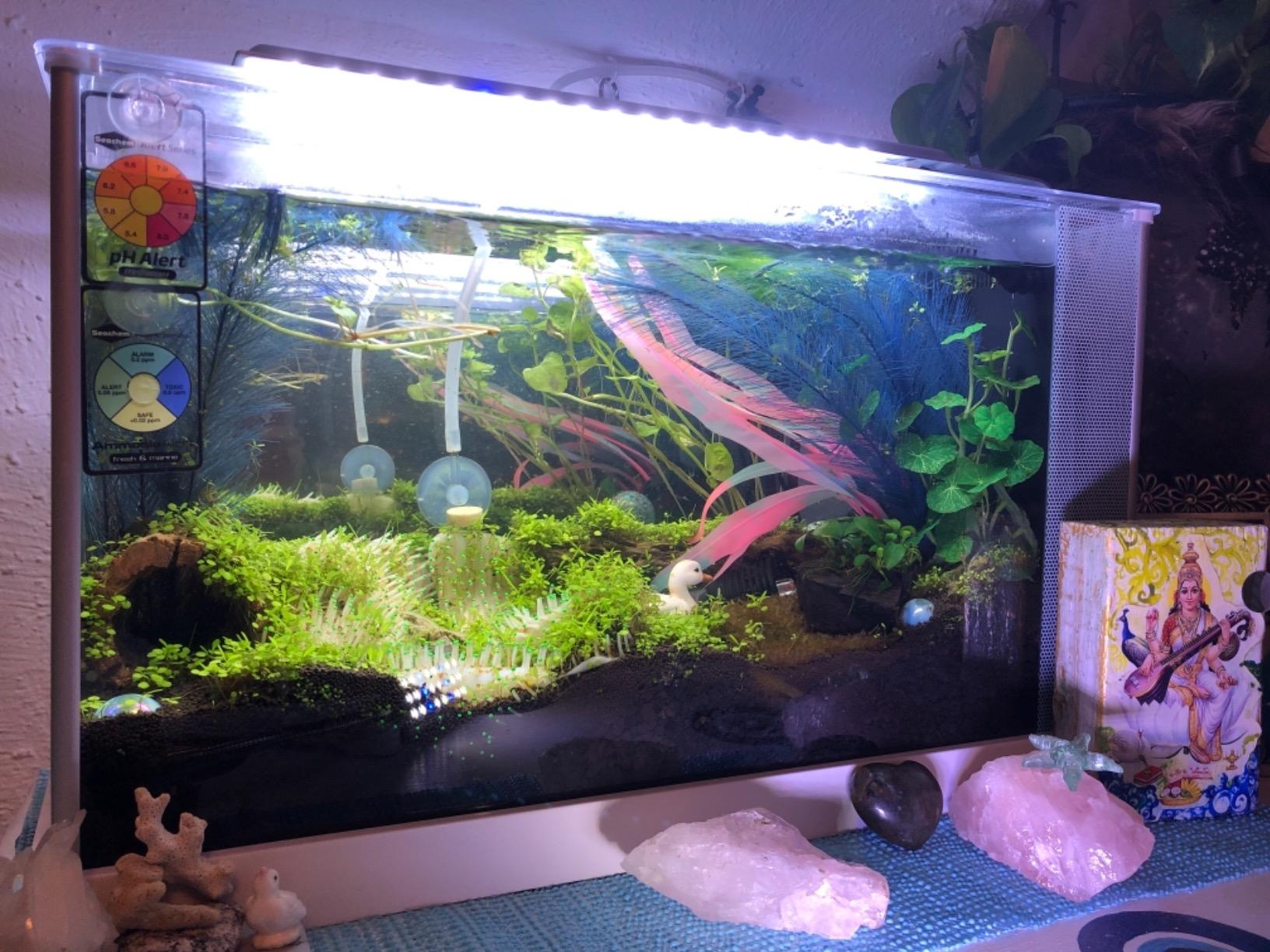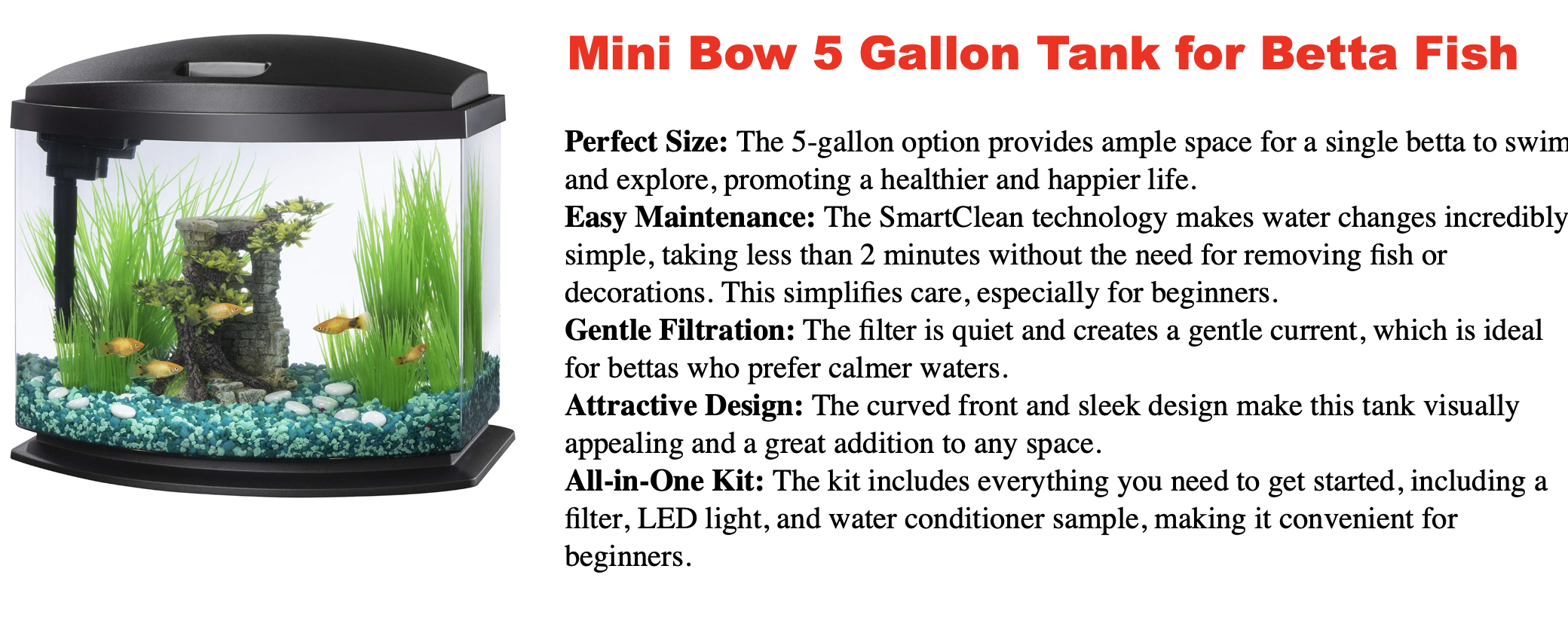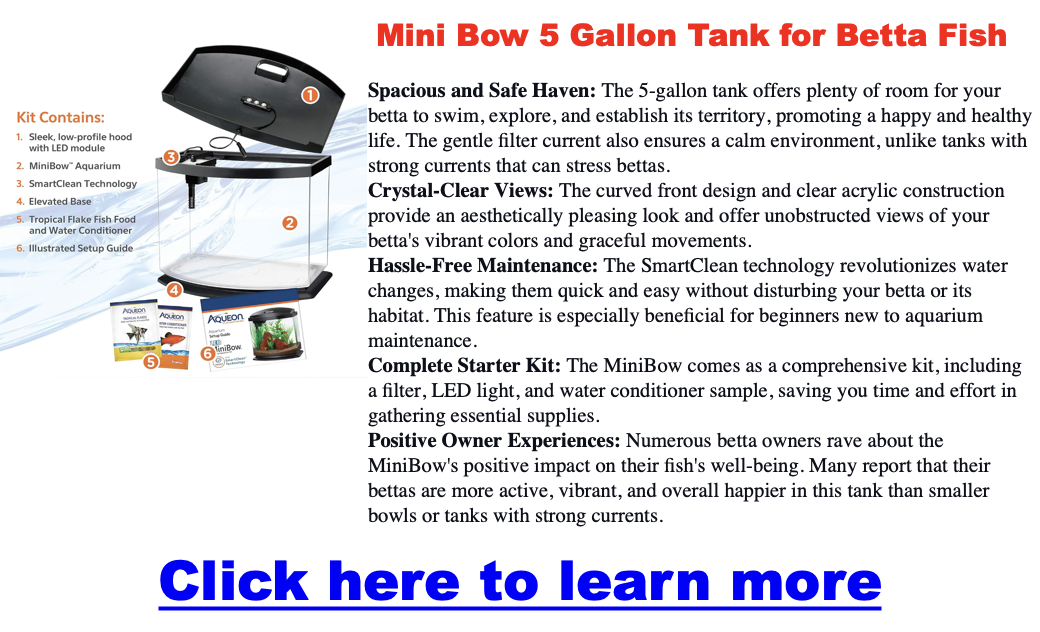How To Choose The Right Betta Fish Tank
A one-gallon tank is not suitable for a betta fish —not only are they too small, but they are difficult to maintain with stable water parameters.
5-gallon heated, filtered, and planted tank with a soil or sand substrate is recommended. Since bettas are tropical fish, they require a heater to prevent temperature fluctuations. If keeping a single betta, a 5-gallon tank is ideal, but if you plan to add tankmates, a 10-gallon tank is recommended.
Surviving is not thriving, and a 1-gallon setup isn’t even sufficient for survival. To save money, consider checking local hobbyist groups or waiting for dollar-per-gallon sales at local fish stores (LFS). Sponge filters are a great low-flow option that minimizes stress while ensuring proper filtration, oxygenation, and water movement.
Additionally, live plants help reduce nitrates, provide resting spots, and outcompete algae. Before setting up a tank, research the nitrogen cycle and consider investing in an API Master Test Kit to monitor water quality.

Best Overall Betta Tank – Fluval Spec Aquarium Kit
Top Betta Fish Tank Options
| Tank Name | Capacity | Features | Notes |
|---|---|---|---|
| Fluval Spec Aquarium Kit | 5 gallons | Advanced filtration, LED lighting | Sleek design with space to add a heater. |
| Marineland Portrait Aquarium | 5 gallons | Hidden filtration, LED lighting | Modern portrait glass design with moonlight mode. |
| Aqueon LED MiniBow Kit | 2.5 or 5 gallons | LED lighting, SmartClean Technology | Compact design, includes food and water care sample. |
| Tetra LED Cube Aquarium | 3 gallons | Clear cube, LED lighting, Tetra 3i filter | Compact and offers a 360° view. |
| Koller AquaView Aquarium | 2 gallons | 7-color LED lighting, internal power filter | Cylindrical design for full viewing. |
| Fluval Betta Premium | 2.6 gallons | Compact design, suitable for children | Best for beginners or as a decorative tank. |
| Glofish Betta Shadowbox | 3 gallons | Impact-resistant plastic, LED lighting | Provides ample space for betta comfort. |
| ERAARK Self-Cleaning Tank | 4.5 gallons | Self-cleaning system, modern design | Ideal for low-maintenance setups. |
Betta Fish Habitat
What size tank do betta fish need
Click here for my favorite betta fish tank that has built-in filtration
While you might find some sources suggesting smaller tanks, providing your betta fish with ample space is crucial for their well-being. Here’s a breakdown of tank size recommendations:
- Minimum: 5 gallons (19 liters) is the absolute minimum. Anything smaller restricts their movement and leads to poor water quality, which can cause stress and health problems.
- Recommended: 10 gallons (38 liters) is ideal. This size offers more swimming space, promotes exploration, and makes maintaining stable water conditions easier.
- Even Better: Consider 15+ gallons for an even richer environment. This allows for more decorations, plants, and even the possibility of compatible tank mates.
Here are some things to consider:
- Tank Size: 5 gallons at minimum is recommended, but larger is always better. A bigger tank provides more swimming space and helps maintain stable water parameters.
- Water Temperature: Bettas prefer a water temperature between 78-80°F (25-27°C). A good tank heater is essential for maintaining a consistent temperature.
- Filtration: A gentle filter is necessary to keep the water clean and remove waste. However, avoid strong currents as bettas prefer calmer waters.
- Water Quality: Regular water changes and monitoring of pH, nitrite, ammonia, and nitrate levels are crucial for your betta’s health.
- Heating and Lighting: Invest in a reliable heater to maintain a stable water temperature. An LED light with adjustable brightness can create a visually appealing environment.
- Aesthetics and Design: Select a tank that fits your personal style and complements your space. Consider the shape, color, and overall design.
- Budget: Betta tanks can range from affordable to high-end. Set a budget before you start shopping to avoid overspending.
Types of Betta Fish Tanks
Click here for my favorite 5 gallon tank with built-in filtration
When choosing a tank, you’ll encounter two main materials:
- Glass: Glass tanks are durable, scratch-resistant, and offer excellent clarity. They are the most common choice and come in various shapes and sizes.
- Acrylic: Acrylic tanks are lighter and less prone to breakage than glass. However, they can scratch more easily and may become cloudy over time.
| Brand/Model | Size (Gallons) | Material | Features | Pros | Cons |
|---|---|---|---|---|---|
| Fluval Spec V | 5 | Glass | Sleek design, built-in filtration, LED lighting | Compact, ideal for desktops, aesthetically pleasing | Limited space for decorations |
| Fluval Flex | 9/15 | Glass | Curved front, multi-stage filtration, customizable LED lighting | Unique design, efficient filtration, customizable lighting | Can be more expensive than other options |
| Aqueon LED Aquarium Kit | Various | Glass | Filter, heater, LED light included | Affordable, good for beginners | Basic design |
| Marina 5g LED Aquarium Kit | 5 | Glass | Simple design, energy-efficient LED, quiet filter | Budget-friendly, quiet operation | Limited customization options |
| Tetra Crescent Acrylic | 5 | Acrylic | Lightweight, less prone to breakage, filter and LED light included | Durable, good for beginners | Can scratch easily |
Recreating a Betta Fish’s Natural Habitat
- Bettas are native to Southeast Asia’s shallow, slow-moving, and densely vegetated waters. To mimic this, use plenty of plants and decorations to create a sense of safety and familiarity for your betta.
- At least 5 gallons is recommended, though a 10-gallon tank is ideal. Tanks larger than 15 gallons provide even more room for enrichment and tank mates.
- Opt for longer, shallower tanks instead of tall ones, as these better suit the betta’s swimming preferences.
- Use a filter with a gentle flow, as bettas thrive in calm waters.
- Using a reliable heater, maintain the water temperature between 78-80°F (25-27°C).
- Lighting should be subdued, mimicking the soft light found in their natural environment. A timer can help maintain a day/night cycle.
- Incorporate aquarium plants such as anubias, Christmas moss, and tall background plants. Bettas enjoy resting on or swimming through these plants and building bubble nests among floating plants. Indian almond (catappa) leaves are also beneficial.
- Decorations should be smooth with no sharp edges. Ensure any holes in decorations are large enough for your betta to swim through safely.
Choosing Tank Mates for Your Betta
While betta fish are often kept alone due to their territorial nature, it’s possible to house them with other compatible species in a larger tank (10 gallons or more). However, careful consideration is crucial to ensure a peaceful community.
Suitable Tank Mates:
- Snails: Nerite snails, mystery snails, and ramshorn snails are peaceful algae eaters that won’t bother your betta.
- Shrimp: Ghost shrimp, cherry shrimp, and amano shrimp can add nice visuals and help clean up leftover food.
- Small, Peaceful Fish: Certain small fish like neon tetras, ember tetras, and harlequin rasboras can live with bettas if the tank is large enough and well-planted.
Unsuitable Tank Mates:
- Other Betta Fish: Never house two male bettas together, as they will fight aggressively. Females can sometimes be kept together in a sorority tank, but this requires careful planning and monitoring.
- Fin-Nippers: Avoid fish known to nip fins, such as tiger barbs or certain types of gouramis.
- Large, Aggressive Fish: Large or aggressive fish will bully or even kill your betta.
Tips for Introducing Tank Mates:
- Quarantine: Always quarantine new fish for at least two weeks to ensure they are healthy and disease-free before introducing them to your betta’s tank.
- Monitor Behavior: Closely observe your betta’s behavior after introducing tank mates. If you see signs of aggression or stress, separate them immediately.
- Provide Hiding Places: Add plenty of plants, caves, and other hiding places to the tank so your betta has a place to retreat if it feels threatened.
Betta Fish Care FAQ
What is the minimum tank size for a betta fish?
While some sources might suggest smaller tanks, the minimum tank size is 5 gallons. Anything smaller restricts their movement and can lead to poor water quality, causing stress and health issues.
What is the ideal tank size for a betta fish?
The ideal tank size for a betta is 10 gallons. This size allows for more swimming space, promotes exploration, and makes maintaining stable water parameters easier.
Can betta fish be kept with other fish?
Male bettas are known for their territorial nature and are best kept alone. However, in larger tanks (10 gallons or more) it is possible to keep them with peaceful, compatible tank mates like snails, shrimp, and certain small fish. Avoid keeping them with other bettas, fin-nippers, large, or aggressive fish.
What kind of filter should I use in my betta tank?
Bettas prefer calm water, so choose a gentle filter. Avoid filters that create strong currents, as this can stress them. Sponge filters and filters with adjustable flow settings are good options.
What temperature should the water be in my betta tank?
Bettas are tropical fish and prefer water temperatures between 78-80°F (25-27°C). A good aquarium heater is essential to maintain a consistent and comfortable temperature for your betta.
Do betta fish need a heater?
Yes, betta fish need a heater. They are tropical fish and require consistent water temperatures of 78-80°F (25-27°C) to thrive.
Can I train my betta fish to do tricks?
Yes, betta fish can be trained to do simple tricks with patience and positive reinforcement. Using food as a reward, you can teach them to follow your finger, swim through hoops, or even jump out of the water for a treat.
Signs of a sick betta fish
Common signs of a sick betta include lethargy, loss of appetite, clamped fins, discoloration, difficulty breathing, and erratic swimming.


